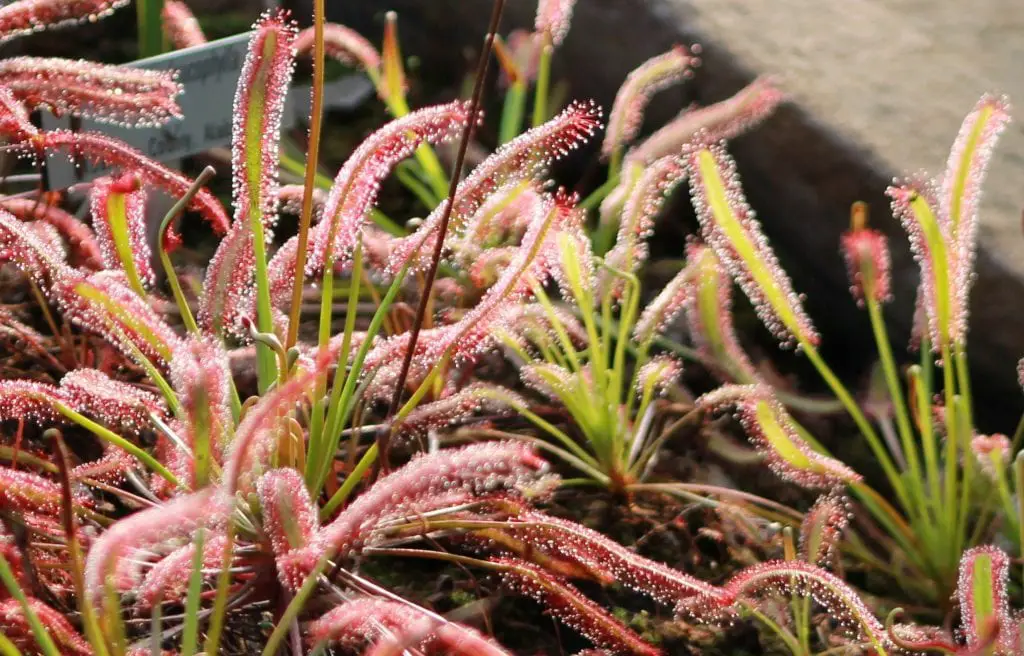
Image – Wikimedia Commons / Roi.dagobert
Are you planning to start a collection of carnivorous plants? If so, I recommend you first purchase one Sundew capensissince in addition to being one of the easiest to take care of, it is also very easy to multiply (in fact, she does it herself).
It grows quite fast, but since it is a rather small plant, it does not take up much space. Next I explain how you should take care of it.
Origin and characteristics

The Sundew capensis It is a rhizomatous perennial carnivorous plant native to the Cape Province of South Africa. It reaches a height of 30 centimeters, with linear leaves up to 6,5 cm long covered by hairs called trichomes that secrete a mucilage (sticky substance) that traps insects.
The flowers are pinkThey measure 1cm in diameter and sprout from stems up to 10cm long. They last only one day, but have enough time to self-pollinate right after closing. Once done, they produce a large quantity of seeds that under normal conditions are usually dispersed by the wind; although if they fall into the same pot they germinate there quickly.
Varieties
There are many, but the most popular are:
- Drosera capensis ‘Alba’: or ‘Albino’. Produces white flowers.
- Drosera capensis ‘Red’: it is red in color. It produces dark pink flowers.
- Drosera capensis ‘Narrow leaf’: produces narrow leaves, up to 6mm, and pink flowers.
- Drosera capensis ‘Wide Leaf’: it is similar to the type species, although with wider leaves. The flowers are bright pink.
What are their cares?

If you want to have a copy, I recommend you take care of it as follows:
Location
It is a plant that must be outside, in semi-shade. During the spring and / or autumn, when the sun is not very strong, you can have more exposure to it, but it is not necessary.
Substratum
Blond peat mix (on sale here!) with pearlite (get it for here!) in equal parts.
In no case should you use black peat, mulch or the like, since its pH is higher than its roots tolerate.
Irrigation
Frequent. During the summer you can put a plate underneath and fill it up; and the rest of the time water it about 2 or 3 times a week depending on the rainfall in the area.
Use rain, distilled, or osmosis water.
Subscriber
You do not have to pay itsince otherwise its roots would burn as they are not prepared to absorb the nutrients. It is better to keep it outside and let it feed on the prey it catches; After all, that’s what makes it a carnivorous plant.
Multiplication

Image – Wikimedia Commons / Husk
It multiplies by seeds and division of rhizomes in spring. The way to proceed is as follows:
Seeds
- The first thing to do is fill a pot -plastic- with peat moss mixed with 50% perlite.
- Then, it is watered consciously.
- Afterwards, the seeds are sown on the surface.
- They are then covered with a very thin layer of peat moss.
- The next step is to water with a sprayer.
- Finally, the pot is placed outside, in semi-shade.
This way they will germinate in 2-3 weeks.
Division
You just have to remove it from the pot and, for example with a serrated knife previously disinfected with alcohol, divide the earth bread. Then it will only remain to plant it in individual pots.
Transplant
The Sundew capensis needs a transplant every 2 or 3 springdepending on how long each specimen takes to occupy the container in which it grows 🙂. Use plastic pots with drainage holes.
The step by step to follow is as follows:
- The first thing you have to do is fill the new pots with equal parts blonde peat and perlite, leaving room for the plant.
- Then, remove the sundew from the »old» container, and insert it into the new one. It must be in the center, neither too high nor too low.
- Then fill the pot with the substrate mentioned above.
- Finally, water.
You may notice that nothing grows in a few days. It is normal. Keep the substrate moist (but not watery) and sooner or later you will see that it resumes its growth.
Plagues and diseases
Does not usually have. In hot and dry environments you could have some cochineal, but nothing that cannot be removed with a simple small brush brush.
Rusticity
Being a subtropical sundew, does not resist intense frosts. However, in climates such as the warm Mediterranean, with minimum temperatures of up to -2ºC, it can be grown outdoors all year round. In the case of living in an area with colder winters, you should keep it in a greenhouse or in a bright room until spring returns.
What uses does the Sundew capensis?

It is used only as ornamental planteither in carnivorous compositions or as a table plant.
You can buy it in nurseries or making click here.
Enjoy it!
